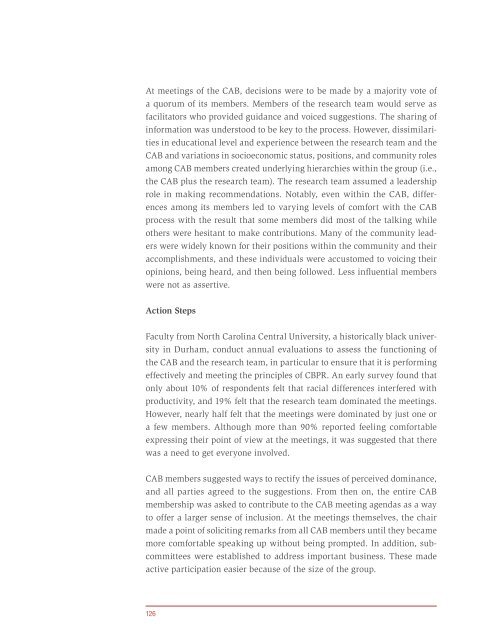Principles of Community Engagement (Second Edition)
Principles of Community Engagement (Second Edition)
Principles of Community Engagement (Second Edition)
You also want an ePaper? Increase the reach of your titles
YUMPU automatically turns print PDFs into web optimized ePapers that Google loves.
At meetings <strong>of</strong> the CAB, decisions were to be made by a majority vote <strong>of</strong><br />
a quorum <strong>of</strong> its members Members <strong>of</strong> the research team would serve as<br />
facilitators who provided guidance and voiced suggestions The sharing <strong>of</strong><br />
information was understood to be key to the process However, dissimilarities<br />
in educational level and experience between the research team and the<br />
CAB and variations in socioeconomic status, positions, and community roles<br />
among CAB members created underlying hierarchies within the group (i e ,<br />
the CAB plus the research team) The research team assumed a leadership<br />
role in making recommendations Notably, even within the CAB, differences<br />
among its members led to varying levels <strong>of</strong> comfort with the CAB<br />
process with the result that some members did most <strong>of</strong> the talking while<br />
others were hesitant to make contributions Many <strong>of</strong> the community leaders<br />
were widely known for their positions within the community and their<br />
accomplishments, and these individuals were accustomed to voicing their<br />
opinions, being heard, and then being followed Less influential members<br />
were not as assertive<br />
Action Steps<br />
Faculty from North Carolina Central University, a historically black university<br />
in Durham, conduct annual evaluations to assess the functioning <strong>of</strong><br />
the CAB and the research team, in particular to ensure that it is performing<br />
effectively and meeting the principles <strong>of</strong> CBPR An early survey found that<br />
only about 10% <strong>of</strong> respondents felt that racial differences interfered with<br />
productivity, and 19% felt that the research team dominated the meetings<br />
However, nearly half felt that the meetings were dominated by just one or<br />
a few members Although more than 90% reported feeling comfortable<br />
expressing their point <strong>of</strong> view at the meetings, it was suggested that there<br />
was a need to get everyone involved<br />
CAB members suggested ways to rectify the issues <strong>of</strong> perceived dominance,<br />
and all parties agreed to the suggestions From then on, the entire CAB<br />
membership was asked to contribute to the CAB meeting agendas as a way<br />
to <strong>of</strong>fer a larger sense <strong>of</strong> inclusion At the meetings themselves, the chair<br />
made a point <strong>of</strong> soliciting remarks from all CAB members until they became<br />
more comfortable speaking up without being prompted In addition, subcommittees<br />
were established to address important business These made<br />
active participation easier because <strong>of</strong> the size <strong>of</strong> the group<br />
126

















